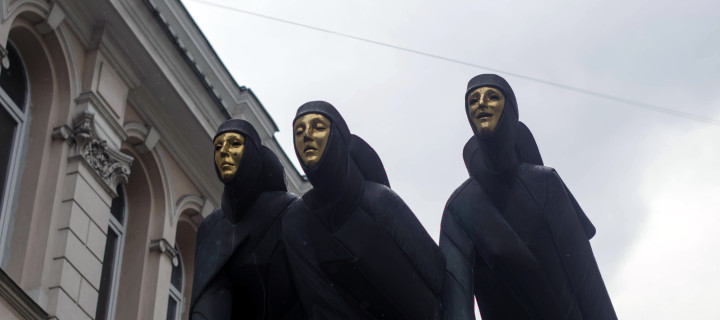I. The Birth of the Golden Snake
Once upon a time – actually, at GenCon 2014 in Indianapolis, USA – several of us discovered a design problem for live freeform games. For the last five years, the independent role-playing game scene here in North America has run an expanding series of crowdsourced events under the banner of Games on Demand. Players show up shortly before the convention slot, choose an available game from a menu, and then sit down with the event facilitator to play. This year, we introduced Larps on Demand, a branch of Games on Demand with its own room at Origins and GenCon, and that is where we encountered our problem.
The problem is as follows: GenCon and Origins are both massive conventions full of interesting things and people to see. As such, few attendees want to make intensive four-hour time commitments in this context, and thus we watched as the two-hour Larps on Demand events filled up, while the four-hour events did not and were cancelled. In response, facilitators began to split their four-hour events in two, and running larps in public spaces to attract visibility.
In our post-GenCon debrief, we decided that established live freeform games that lasted two hours such as J. Tuomas Harviainen’s The Tribunal required too many players, whereas a flexible game like Håken Lid and Ole Peder Giæver’s The Hirelings required too much time, and Lizzie Stark’s The Curse required intimate space that was at a premium in a large convention setting. What were we to do?
Thus the Golden Cobra Challenge for October 2014 was born. We would solve this live freeform problem by considering it as a set of design constraints in itself. Scrappy pervasive freeforms were what we needed. Therefore, the game submissions had to:
- Be playable from start to finish in two hours or less, facilitated by people who were not the designer him/herself.
- Be playable by a variable but small number of participants, ideally a wide range like 2–8.
- Be playable in a public space, like an open lounge in a busy hallway.
- Optional: Use the ingredients Chord, Light, Solution, Bear and Minute.
We advertised it as a “friendly contest open to anyone interested in writing and playing freeform games,” and even provided a much-utilized mentor program for freeform designers who wanted to bounce their ideas off a partner. We would award prizes in categories corresponding with our design needs: Most Convention- Ready, Most Appealing to Newcomers, Cleverest Design, and Game We’re Most Eager to Play. That being said, the prize for each category was that the game would be run at least once at Metatopia in November 2014.
II. The Baddest-Ass Snakes in the Jungle
What came of it? Over 50 freeform submissions poured in from around the world, addressing the design constraints with verve and creativity. Designers and theorists once again debated definitions of “freeform”, while others saw fit to troll the contest with unmarked submissions (e.g. Vampire Death Party by A. Nohn Knee-Mus). As the judges volunteering our time, we could only scramble to keep up with the breadth of entries submitted by experienced and novice designers alike. In fact, the contest itself served as a sort of “permission and validation engine” for people who did not consider themselves designers – even for those beset with imposter syndrome – to create live freeforms.
New designers were most welcome. As Wendy Gorman, co-designer (with David Hertz and Heather Silsbee) of Still Life, commented:
I was shocked and delighted [by winning a Golden Cobra], and could not have been more pleased to see something of mine played by people who are well respected in the field of game design, especially since I am not a game designer, and have never considered that I could become one.
Two hours, a public space, and a flexible player number meant that a short set of easy-to-communicate rules proved the best design strategy. Because few veteran designers had much experience in addressing the constraints, the playing field proved more level than in other RPG design contests. After all, we preferred to cultivate a broad community that would produce more games, rather than promoting exclusivity and competition among creators. Mentoring during the contest and rewarding the winning designs with actual play appeared the best ways to nurture such a community of play.
The hard-selected winners of the contest came from a pool of the weird, wacky and dramatic. Some entries in this pool included Active Shooter by Tim Hutchings, a serious freeform dealing with the school shooter phenomenon; Snow by Agata Lubańska, about an explosive family situation in a snowed-in car; Keymaster by J Li, a ritual of creating fictional identities; and If I Were President by James Stuart, which enacts a surreal presidential debate in the far future. Contest winners often adhered closest to the given constraints. Still Life, a game about relationships between rocks, positions players as inanimate objects being moved around by elemental forces in a public space.
Group Date by Sara Williamson embraces chaos, with the same date between two people being played out simultaneously by multiple groups. Glitch Iteration by Jackson Tegu explores fragmented computer memory and has players directly experience their surroundings as unstable simulations. Finally, Unheroes by Joanna Piancastelli deals with a group of superheroes who have altered reality to cover up a terrible mistake and must now make a critical decision. Many of the games would perform well in busy GenCon hallways in Indianapolis, as they did in the Metatopia hall.
III. The Golden Cobra Hand Signal
Live freeform in the United States has a history of being behind closed doors and opaque for newcomers. The Golden Cobra Challenge sought to amend that culture and, at the very least, create a stable of new games to try out at Games on Demand in GenCon 2015 and other conventions. But what it also produced – besides innovative new sets of rules and role-playing scenarios – was a quasi-new social phenomenon: role-players out in public playing games designed for public interference. Emerging from Metatopia, the Golden Cobra Hand Signal – putting one’s elbow in one’s hand and forming a snake face with the other hand – lets others know that, while you may be out in a park or hallway, you are actually also in the middle of playing a game and a role.
Games like Still Life encourage outsiders to affect and interact with these players, but the outside world may still not necessarily understand what they are doing. As these drop-in-friendly live freeforms spread and mutate, we hope to see more of these arcane gestures coming to a convention near you.
This article was initially published in The Knudepunkt 2015 Companion Book which was edited by Charles Bo Nielsen & Claus Raasted, published by Rollespilsakademiet and released as part of documentation for the Knudepunkt 2015 conference.






